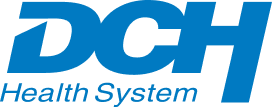
- About Us
- DCH Health System History
DCH Health System History
A Century of Top-Tier Medical Care in Tuscaloosa
At DCH Health System, we are proud of our history and how we have evolved over 100 years. We have seen our community grow as scientific research has developed new and improved medical services.
1916 - 1923: Tuscaloosa Raises Funds to Open a Small Medical Clinic
In 1916, Tuscaloosa took the first step toward providing the healthcare its citizens needed. Its population had doubled since the city was founded in 1819. This increase in population spurred community members to start funding, building and equipping a 12-bed medical center to be called the Druid City Infirmary, which would eventually transform from a small clinic into the DCH Health System.
The Druid City Infirmary opened in 1916 on Broad Street, now known as University Boulevard. It was funded by bonds and public subscriptions. A local committee determined that the small clinic was insufficient to serve the needs of Tuscaloosa and Northport. The committee was appointed by the Tuscaloosa County Medical Association, the Board of Trade and the Rotary Club. Their purpose was to study alternatives to improve local health care and raise funds to build and equip a modern hospital. To do so, the committee raised funds with the slogan “For Humanity Here at Home.”
It worked. The public matched a $50,000 bond issue with an additional $50,000, meeting the challenge. University of Alabama President George Denny supported the cause by donating Lawn State, at the corner of University Blvd. and Hackberry Lane, for the new hospital. As excavation began in March 1922 on the site at the edge of the University campus, the committee chose a new name for the new facility: “Druid City Hospital.” This title, selected from among suggestions from the community, would retain Tuscaloosa's distinctive nickname and the name of the infirmary that preceded it.
1923 – 1957: As Tuscaloosa Grew, So Did the Health Care Needs of its Population
Once the Druid City Hospital opened in 1923, it was heralded by The Tuscaloosa News "as the greatest achievement from a humanitarian viewpoint accomplished by the present generation," an achievement that was not without some "personal sacrifice." The time for sacrifice was not yet over; the board saw an immediate need for an additional $25,000 to equip the 50-bed hospital. Within a week, the community raised the money.
Druid City Hospital eventually expanded to 80 beds to meet the health care needs of its growing city. By World War II, it was apparent that the city had outgrown its modest hospital, just as it had outgrown its infirmary two decades before. Joseph Allen Duckworth, president of the private nonprofit corporation that operated the hospital, challenged the new generation to put up as did the founders, to bring to Tuscaloosa and Northport the quality health care they deserved.
In 1946, the hospital board took its first steps to address the county’s health care needs by restructuring the private, nonprofit board that had operated the hospital since it opened, because it could not raise the necessary funds to meet the needs of a growing city. So, the board turned over its assets to the city and county governing boards, and later that year, government officials leased a portion of Northington General Hospital. This temporary Army hospital closed at the end of World War II. The Northington complex, where University Mall now stands, would serve as a temporary home for Druid City Hospital until a new hospital could be financed and constructed.
Tuscaloosa County residents responded to this new challenge by imposing on themselves a temporary 1 cent sales tax to finance the construction of a new hospital. The legislation that established the sales tax also created a nine-member board of directors for the hospital, with members appointed by area governing bodies and the county medical society. This tax was ended when the hospital opened in 1952. The current tax is divided among several county entities, including local governments and school boards and the hospital.
As the population in Tuscaloosa grew to well over 50,000 people, community residents eagerly followed the construction of the hospital throughout the early 1950s. In December 1952, Tuscaloosa County received an early but long-awaited Christmas gift: Druid City Hospital employees and community volunteers moved 77 patients from the Northington location to the new hospital on University Boulevard. Sales tax revenue, combined with federal funds available through the Hill-Burton Act, provided the more than $3 million needed to construct the new Druid City Hospital.
The new 240-bed hospital, so progressive it earned coverage in Modern Hospital and Life magazines, featured piped-in oxygen at every bedside, 4 major operating rooms, and the state's first surgical recovery room. DCH continued to grow to keep pace with its evolving role as a regional medical center serving a seven-county area of more than 220,000 persons.
DCH in the 1960s through the 1990s
By 1976, additions at the hospital brought the number of beds up to 496. The same year, the hospital opened a five-story wing that made DCH the state's third-largest hospital. As a regional medical center, DCH attracted physician specialists and constructed specialty units, including an intensive care nursery, coronary and intensive care units, sub intensive care units, open-heart surgery, an orthopedic unit and a pediatric unit.
In the 1980s, expansion occurred off the campus of DCH Regional Medical Center when the DCH Health System became affiliated with Fayette Medical Center in Fayette, Alabama. This partnership, which began in 1984, further offered residents in West Alabama the best possible health care. Specialty clinics offered at the Fayette Medical Center include oncology, cardiology, urology, neurology, orthopedics, ophthalmology and plastic surgery. The facility also has a 122-bed nursing care facility that has been officially accredited and licensed for intermediate and skilled nursing care.
The 1990s brought more expansion when Northport Medical Center became part of the DCH Health System in 1992. Northport Medical Center was already a full-service community hospital that offered diverse and up-to-date services when it became part of the system. Today, the facility is home to services such as the Comprehensive Joint Program, Women's Pavilion and the North Harbor Pavilion, which offers psychiatric services for adults and geriatric patients.
DCH in the 21st Century
The history of the DCH Health System is not the history of a building or a health care system. It is the story of a community's continuing response to provide for itself one of the most critical commodities a community can offer – health care.

